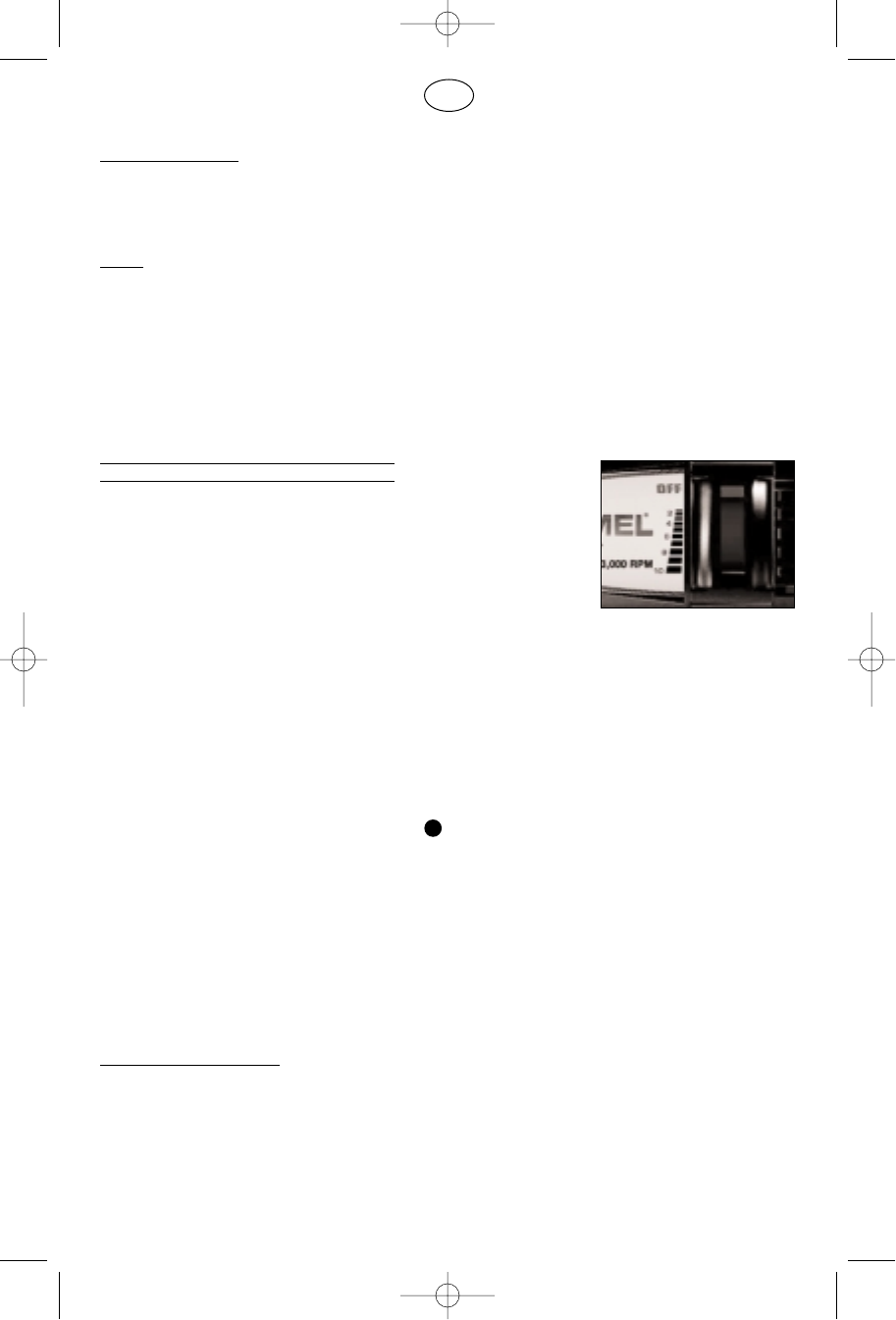
23
GB
APPLICATION ADVICE
• Always practice on a piece of scrap material first to choose the right accessory and determine the optimum
working speed
• Do not apply to much pressure on the tool; let the speed do the work for you
• Use only accessories that are recommended by the manufacturer for your model.
SPEED
There are 2 basic types of Rotary Tools: two-speed and variable speed models. On the two-speed model, there
is a LOW and HIGH switch. When the switch indicator is on the “LOW” low setting, the tool runs at 15,000 RPM.
When the switch indicator is on the “HIGH” high setting, the tool runs at about 33,000 RPM. On the variable speed
model, there is a switch indicator with a black line on it. Slide to the number on the housing to select the operating
speed needed from 10,000 - 33,000 RPM. You can refer to the charts on page 4,5,6 and 7 to determine the proper
speed, based on the material being worked and the type of cutter or other accessory being used. These charts
enable you to select both the correct accessory and the optimum speed at a glance.
The Settings for Approximate Revolutions Per Minute Rotary Tool Variable Speed Model 395
Switch Setting Speed Range
1-2 10,000 - 14,000 RPM
3-4 15,000 - 19,000 RPM
5-6 20,000 - 24,000 RPM
7-8 25,000 - 29,000 RPM
9-10 30,000 - 33,000 RPM
Some rules of thumb in regard to speed:
1. Plastic and materials that melt at low temperatures should be cut at low speeds.
2. Polishing, buffing, and cleaning with a wire brush must be done at speeds below 15,000 RPM to prevent
damage to the brush.
3. Wood should be cut at high speed.
4. Iron or steel should be cut at top speed if using tungsten carbide accessory, but at lower speeds if using high
speed steel cutters. If a high speed steel cutter starts to chatter-this normally means it is running to slow.
5. Aluminum, copper alloys, lead alloys, zinc alloys and tin may be cut at various speeds, depending on the type
of cutting being done. Use paraffin or other suitable lubricant on the cutter to prevent the cut material from
adhering to the cutter teeth.
To aid you in determining the optimum operational speed for different materials and different accessories, we have
constructed a series of tables that appear on diagram . By referring to these tables, you can discover the
recommended speeds for each type of accessory. Look these tables over and become familiar with them.
Ultimately, the best way to determine the correct speed for work on any material is to practice for a few minutes on
a piece of scrap, even after referring to the chart. You can quickly learn that a slower or faster speed is more
effective just by observing what happens as you make a pass or two at different speeds. When working with
plastic, for example, start at a slow rate of speed and increase the speed until you observe that the plastic is
melting at the point of contact. Then reduce the speed slightly to get the optimum working speed.
Increasing the pressure on the tool is not the answer when it is not cutting as you think it should. Perhaps you
should be using a different cutter, and perhaps an adjustment in speed would solve the problem. But leaning on the
tool seldom helps.
MAINTENANCE AND REP
AIR
• Keep tool and cord clean (some household cleaning products and solvents can damage plastic parts; these
products include among others benzine, trichloroethelene, chloride, amonium
• Excessive sparking mostly indicates worn-out carbon brushes, therefor your tool should be brought to a
service station.
• In case of an electrical or mechanical defect, hand in tool at one the DREMEL Service Stations for repair
(addresses are listed on the service diagram supplied with the tool)
6
The speed of the rotary tool is
controlled by setting this
indicator on the housing.
395/285_star2 08.03.2001 13:55 Uhr Seite 23


















